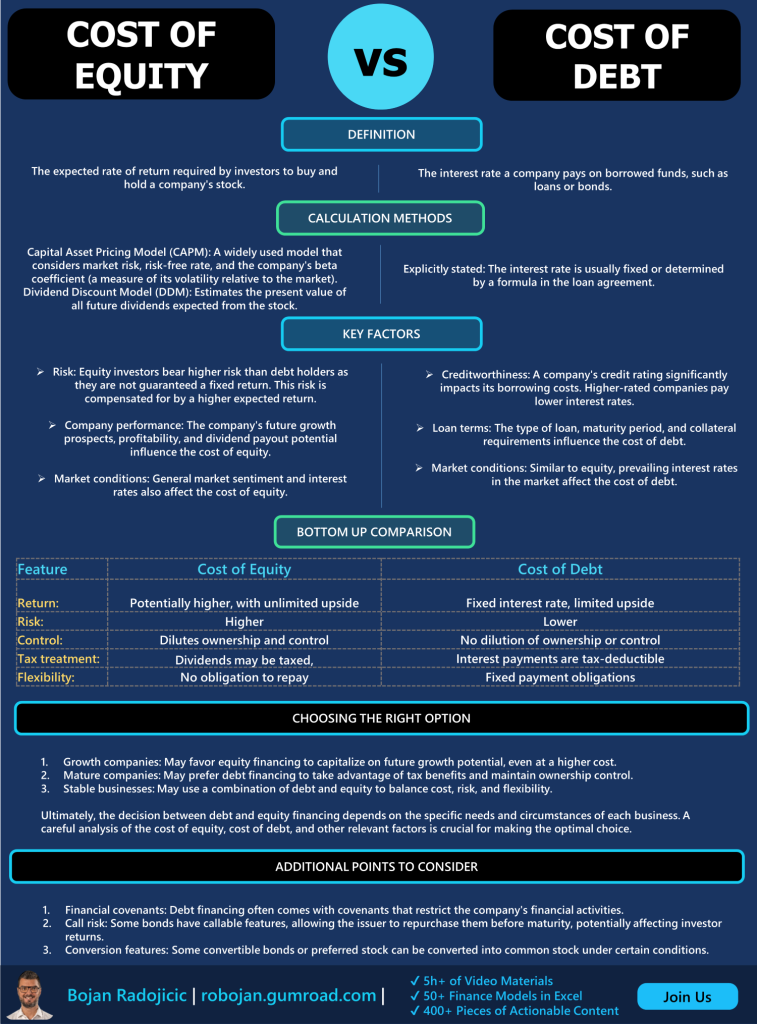In the realm of corporate finance, the concepts of cost of equity and cost of debt are fundamental pillars, each wielding its distinct significance in assessing a company’s financial health and making informed financial decisions.
These two financial metrics diverge in their origin, calculation, and implications, yet share a common goal of determining the cost associated with a company’s capital structure.
Cost of Equity: Unlocking the Value of Ownership
The cost of equity embodies the compensation demanded by shareholders and investors for their ownership stake in a company. It is the return they anticipate to justify the risk associated with holding equity, whether in the form of common stock or other equity instruments.
The concept rests on the premise that shareholders expect a certain rate of return on their investment, akin to a dividend yield or capital gains.
Calculating the cost of equity often involves deploying intricate models, such as the Dividend Discount Model (DDM) or the Capital Asset Pricing Model (CAPM).
These models account for factors like the company’s historical performance, projected future earnings, and the prevailing market conditions.

Cost of Debt: The Price of Borrowed Capital
On the flip side, the cost of debt pertains to the expense incurred by a company when it borrows funds from external sources. This can take the form of loans, bonds, or any other debt instrument.
Unlike equity, where investors share in ownership and profits, debt providers seek a predetermined interest rate as compensation for lending their capital.
The cost of debt is relatively straightforward to determine as it equates to the interest rate agreed upon in the lending arrangement. It remains largely unaffected by market fluctuations or the company’s performance, given the contractual nature of debt obligations.
Cost of Equity vs. Cost of Debt: A Comparative Analysis
Choosing between debt and equity financing is a crucial decision for any business. Both have their advantages and disadvantages, and the optimal choice depends on various factors like the company’s financial health, risk tolerance, and future growth plans.
However, understanding the cost of equity and the cost of debt is essential for making an informed decision.
Cost of Equity
Definition
The expected rate of return required by investors to buy and hold a company’s stock.
Key factors
Risk: Equity investors bear higher risk than debt holders as they are not guaranteed a fixed return. This risk is compensated for by a higher expected return.
Company performance: The company’s future growth prospects, profitability, and dividend payout potential influence the cost of equity.
Market conditions: General market sentiment and interest rates also affect the cost of equity.
Calculation methods:
Capital Asset Pricing Model (CAPM): A widely used model that considers market risk, risk-free rate, and the company’s beta coefficient (a measure of its volatility relative to the market).
Dividend Discount Model (DDM): Estimates the present value of all future dividends expected from the stock.
Cost of Debt
Definition
The interest rate a company pays on borrowed funds, such as loans or bonds.
Key factors
Creditworthiness: A company’s credit rating significantly impacts its borrowing costs. Higher-rated companies pay lower interest rates.
Loan terms: The type of loan, maturity period, and collateral requirements influence the cost of debt.
Market conditions: Similar to equity, prevailing interest rates in the market affect the cost of debt.
Calculation method
Explicitly stated: The interest rate is usually fixed or determined by a formula in the loan agreement.
Comparison:
| Feature | Cost of Equity | Cost of Debt |
| Return | Potentially higher, with unlimited upside | Fixed interest rate, limited upside |
| Risk | Higher | Lower |
| Control | Dilutes ownership and control | No dilution of ownership or control |
| Tax treatment | Dividends may be taxed, | Interest payments are tax-deductible |
| Flexibility | No obligation to repay | Fixed payment obligations |
Choosing the Right Option:
Growth companies
May favor equity financing to capitalize on future growth potential, even at a higher cost.
Mature companies
May prefer debt financing to take advantage of tax benefits and maintain ownership control.
Stable businesses
May use a combination of debt and equity to balance cost, risk, and flexibility.
Ultimately, the decision between debt and equity financing depends on the specific needs and circumstances of each business. A careful analysis of the cost of equity, cost of debt, and other relevant factors is crucial for making the optimal choice.
Additional Points to Consider:
Financial covenants
Debt financing often comes with covenants that restrict the company’s financial activities.
Call risk
Some bonds have callable features, allowing the issuer to repurchase them before maturity, potentially affecting investor returns.
Conversion features
Some convertible bonds or preferred stock can be converted into common stock under certain conditions.
By understanding the nuances of the cost of equity and the cost of debt, businesses can make informed financing decisions that support their long-term growth and success.


